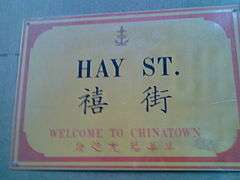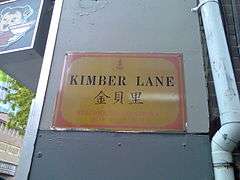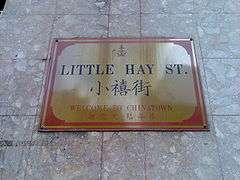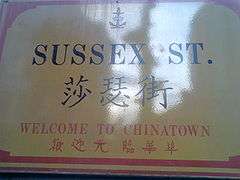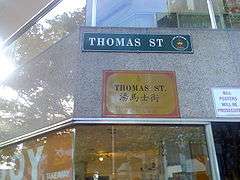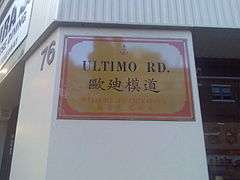Chinatown, Sydney
Chinatown (Chinese: 悉尼唐人街; pinyin: xīní tángrénjiē; Jyutping: sik1nei4 tong4jan4gai1) is an urban enclave situated in the southern part of the Sydney Central Business District, in New South Wales, Australia. It is located and comprises the majority of the Haymarket suburb, between Central station and Darling Harbour. It is part of the local government area of the City of Sydney and is Australia's largest Chinatown.[2]
| Chinatown Sydney, New South Wales | |||||||||||||||
|---|---|---|---|---|---|---|---|---|---|---|---|---|---|---|---|
 A Chinese paifang at the intersection of Factory Street and Dixon Street | |||||||||||||||
| Population | 22,218 (2018)[1] | ||||||||||||||
| • Density | 44,000/km2 (115,000/sq mi) | ||||||||||||||
| Postcode(s) | 2000 | ||||||||||||||
| Area | 0.5 km2 (0.2 sq mi) | ||||||||||||||
| LGA(s) | City of Sydney | ||||||||||||||
| State electorate(s) | Sydney | ||||||||||||||
| Federal Division(s) | Sydney | ||||||||||||||
| |||||||||||||||
| Sydney Chinatown | |||||||||||||||
|---|---|---|---|---|---|---|---|---|---|---|---|---|---|---|---|
| Traditional Chinese | 悉尼唐人街 | ||||||||||||||
| Simplified Chinese | 悉尼唐人街 | ||||||||||||||
| |||||||||||||||
| Alternative Chinese name | |||||||||||||||
| Traditional Chinese | 雪梨華埠 | ||||||||||||||
| Simplified Chinese | 雪梨华埠 | ||||||||||||||
| |||||||||||||||
| Second alternative Chinese name | |||||||||||||||
| Traditional Chinese | 悉尼中國城 | ||||||||||||||
| Simplified Chinese | 悉尼中国城 | ||||||||||||||
| |||||||||||||||
Sydney and the colony of New South Wales experienced Chinese migration as early as 1828. The first group of Chinese labourers from Amoy (modern day Xiamen) embarked for New South Wales in 1848. With the discovery of gold in 1851, Chinese immigration increased and by 1855, the number of Chinese immigrants reached 17,000.[3] The Chinese population had traditionally been represented by those who came from Southern China (i.e. provinces such as Guangdong and Fujian) due to the majority of colonial ports being located in the southern coast of China.[4]
History
One of the many nationalities to arrive in Australia in the Gold Rush years of the 1850s were the Chinese. Large groups stayed after the Gold Rush years ended. Many settled in their own communities, working in locations across Sydney. Some of these Chinese immigrants became gardener's on the city's fringe.[5] By 1861 there were some 13,000 Chinese living in New South Wales, during this time the Chinatown was in The Rocks district, also known as the 'Chinese Quarter'.[6] Anti-immigration sentiment was rife during the 1880s and a Royal Commission into "Alleged Chinese Gambling and Immorality" began in 1892, due to the amount of opium dens and brothels that were found in the area, similar to Melbourne's Chinatown. This attitude of negativity towards the Chinese had settled down by the time of Federation in 1901. By the 1920s, Sydney's Chinatown migrated over to Campbell Street, and was then placed with the Capitol Theatre.
Since 2019, Dixon Street and other intersecting streets are completely vehicle-free every Friday from 4pm in order to host the Friday night markets. Different stands selling Asian street food, desserts, and confectionary line the streets and alleys and the markets can become extremely busy.[7]
Location
Traditional boundaries
Officially, Chinatown does not have clearly defined borders, due to its continuous growth. The traditional core of the Haymarket Chinatown has been centred around Dixon Street, a pedestrian street mall with many Chinese restaurants, and with a paifang (a traditional Chinese gateway) at each end. At the eastern side, running parallel with Dixon Street, are Sussex Street and George Street, Sydney city's main thoroughfare. Other streets and lanes within Sydney's Chinatown include Factory Street, Goulburn Street, Little Hay Street, Kimber Lane and Thomas Street.
At the eastern end of Chinatown, at the corner of George Street and Hay Street, there is a sculpture made from a dead tree trunk; created by artist Lin Li in 1999 and named Golden Water Mouth.[8] Its designer believed that it would bring good fortune to the Chinese community.
Recent expansion
The current location of modern day Chinatown is actually the third known area to have been considered a Chinatown. When Sydney's produce market moved from what became the site of the Queen Victoria Building to the Belmore Markets, the Haymarket and Surry Hills areas became the focus for Sydney's Chinese citizens. By the 1920s Chinatown began to consolidate at its current location.[5]
On Hay Street, the construction of The Peak Apartments, a residential skyscraper, in 1996 and the newly renovated Market City shopping complex built over the Paddy's Market further consolidated Chinatown. Market City contains food courts with chain restaurants (such as Haidilao), an 800+ seat Dim Sum Restaurant (The Eight Modern Chinese Restaurant), boutique shops, City Amusements (a large indoor entertainment complex), and the Haymarket Paddy's Markets, a Wednesday-to-Sunday produce and flea market.[9] Likewise, the completion of Darling Square in late 2017 adjacent to Market City added multiple new apartment complexes and a plethora of new facilities and restaurants that fully integrated Chinatown into the urban core of Sydney.[10]
Unlike the Chinatowns in some other countries, Sydney's Chinatown has been relatively free of crime and hygiene issues. However, since there are many skyscrapers in Sydney, there are some concerns within the Chinese community about the building height restrictions imposed by the image-conscious local government authorities.
Suburbification
There are also satellite Chinatowns that have emerged in the past two decades in several Sydney suburbs such as Cabramatta, Ashfield, Hurstville, Eastwood, Campsie, Parramatta, Chatswood, Burwood, Flemington and Kingsford. Each of these suburbs are increasingly diverse in that people from specific regions in China settle together in one suburb, traditionally known as an ethnic enclave. For example, Ashfield is known as 'little Shanghai'[11] whilst Hurstville has a high concentration of people from Hong Kong.[12] However, Sydney's Chinatown still remains both a social and cultural centre for the Chinese Australian community in Sydney as it continues to expand.[13]
Demographics
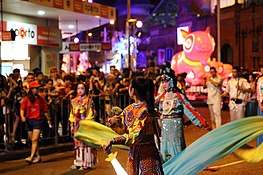
According to the Australian Bureau of Statistics, in 2016 the Chinatown and Haymarket area included a significant population of Chinese (31.9%), Thai (18.3%), Indonesian (5.6%), English (5.1%) and Korean (4.8%) population. The most spoken languages at home apart from English were Thai (20.4%), Mandarin (20.3%), Indonesian (10.2%), Cantonese (5.1%), and Korean (4.8%).[14] Furthermore, there is a significant student population from Asia, due to the close proximity of educational institutions such as the University of Technology Sydney, Technical and Further Education (TAFE NSW), and the University of Sydney. As of 2016, 25.9% of the residents in Chinatown were studying at university or TAFE[15] and 33.4% of individuals in the Haymarket area had a attained a bachelor's degree or above.
As a centrally located Chinatown (that is adjacent to, and being gradually absorbed by the growing central business district), there are many white collar workers. Out of the 65,950 workers in the surrounding area in 2017, 18% worked in finance & financial services, 17% in the government, and 13.6% in professional & business services.[16] The median weekly household income in 2016 was $1,696, slightly above the national average of $1,659 in 2019.[17]
Chinese Garden of Friendship
Sydney is the sister city of Guangzhou in China,[18] and as a gift to Sydney during the Australian Bicentenary in 1988, the Chinese Garden of Friendship (simplified Chinese: 谊园; traditional Chinese: 誼園; pinyin: yìyuán) was constructed west of Chinatown in the Darling Harbour precinct. The relationship between Sydney and Guangzhou (previously Romanized as Canton), the capital of Guangdong province, is particularly strong because of trade and migration since the earliest days of colonisation. The agreement stipulated Guangdong would provide the design of the garden and key building materials, furniture and artworks that are intrinsic to the classic garden typology, while New South Wales would manage and fund its construction through the Darling Harbour Authority. It is one of the few public traditional Chinese gardens outside of China and is a horticultural expression of a private garden and can also be classified as a scholar's or classical garden.[19] The gardens were added to the New South Wales State Heritage Register on 5 October 2018.[20] The garden hosts activities such as lessons on its history and design philosophy, landscape tours, school visits, wedding functions, koi fish feeding, among others.[21]
Bilingual street signs
There are many bilingual street signs across Chinatown, denoting the name of streets, lanes, and roads in both English and Chinese. Interestingly, some of the names are based on their Cantonese pronunciation (e.g. Hay Street, which is pronounced "hei1 gaai1" in Cantonese, but "xǐ jiē" in Mandarin") whilst others are based on their Mandarin pronunciation (e.g. Liverpool Street, which is pronounced "lìwùpŭ jiē" in Mandarin, but "lei6mat6pou2 gaai1" in Cantonese).
Some of these signs are accompanied by their official City of Sydney street signs. On the bottom of each of these signs, it reads, "Welcome to Chinatown" and "歡迎光臨華埠".
Gallery
 Friday Night Markets in Chinatown
Friday Night Markets in Chinatown Entrance to Chinatown via Haymarket, at night
Entrance to Chinatown via Haymarket, at night Night aerial view
Night aerial view Haymarket (2013)
Haymarket (2013)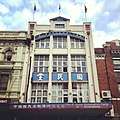 The Sydney office of the Kuomintang
The Sydney office of the Kuomintang.jpg) The Chinese Garden of Friendship
The Chinese Garden of Friendship Corner store in Chinatown
Corner store in Chinatown Lunar New Year celebrations
Lunar New Year celebrations Lunar New Year celebrations
Lunar New Year celebrations
Cultural depictions
- Sydney's Chinatown is the setting and film location of the music video for David Bowie's 1983 single China Girl.[22]
- Parts of Sydney Chinatown appear in the 1999 film Two Hands
- A scene for Dulcea's compound in 20th Century Fox's 1995 superhero film Mighty Morphin Power Rangers: The Movie[23]
- Appeared in The Wolverine in October 2012[24]
See also
References
- https://www.cityofsydney.nsw.gov.au/business/build-your-skills-and-knowledge/business-research-and-data/business-in-your-local-area/chinatown-and-cbd-south
- "Chinatown and Haymarket". Sydney.com. Retrieved 6 June 2013.
- "Chinese Migration Stories". www.records.nsw.gov.au. 22 December 2015. Retrieved 7 April 2020.
- "Chinese Heritage of Australian Federation Project". arrow.latrobe.edu.au. Retrieved 7 April 2020.
- Sharpe, Alan (2000). City of Sydney: Pictorial History. Kingsclear Books. ISBN 9-780-98718408-5.
- deborahw (21 February 2014). "Sydney's Chinese Community in The Rocks". Sydney Living Museums. Retrieved 7 April 2020.
- "Chinatown Night Market | Dixon Street Plaza | Shopping in Sydney". Time Out Sydney. Retrieved 7 April 2020.
- "Golden Water Mouth". cityartsydney.com.au (City of Sydney website). Retrieved 24 April 2020.
- "Market City Sydney | Best Shopping in Chinatown & Haymarket". Market City. Retrieved 7 April 2020.
- Williams, Sue (16 April 2019). "Darling Square: Sydney's new $3.4 billion neighbourhood takes shape". Commercial Real Estate. Retrieved 7 April 2020.
- "Business booms in 'little Shanghai'". The Sydney Morning Herald. 17 June 2011. Retrieved 7 April 2020.
- "In the neighbourhood: Hurtsville". Food. Retrieved 7 April 2020.
- "Eastern promise spreads to the suburbs". The Sydney Morning Herald. 6 September 2002.
- "2016 Census QuickStats: Haymarket". quickstats.censusdata.abs.gov.au. Retrieved 7 April 2020.
- "Chinatown and CBD South - City of Sydney". www.cityofsydney.nsw.gov.au. Retrieved 7 April 2020.
- "Chinatown and CBD South - City of Sydney". www.cityofsydney.nsw.gov.au. Retrieved 7 April 2020.
- Statistics, c=AU; o=Commonwealth of Australia; ou=Australian Bureau of (20 February 2020). "Media Release - Moderate growth in average earnings (Media Release)". www.abs.gov.au. Retrieved 7 April 2020.
- "Sister cities: City of Sydney". 22 February 2019. Retrieved 23 February 2019.
- "Chinese Garden of Friendship". Sydney Harbour Foreshore Authority. Archived from the original on 2 June 2013. Retrieved 6 June 2013.
- "Chinese Garden of Friendship | NSW Environment, Energy and Science". www.environment.nsw.gov.au. Retrieved 7 April 2020.
- "Chinese Garden of Friendship". darlingharbour.com. Retrieved 7 April 2020.
- Davd Bowie dead at 69: The songwriter's time in Australia Daily Telegraph 12 January 2016
- "Filming Location Matching "Chinese Garden of Friendship, Darling Harbour, Sydney, New South Wales, Australia" (Sorted by Popularity Ascending)". IMDb. Retrieved 7 April 2020.
- The Wolverine (2013) - IMDb, retrieved 7 April 2020
External links
- Shirley Fitzgerald (2008). "Chinatown". Dictionary of Sydney. Retrieved 26 September 2015. [CC-By-SA]
- SYDNEY.com - Chinatown and Haymarket
Further reading
| Wikivoyage has a travel guide for Sydney - City South. |
| Wikimedia Commons has media related to Chinatown, Sydney. |
- Fitzgerald, Shirley (1997). Red Tape, Gold Scissors (The story of Sydney's Chinese) (Paperback). State Library of New South Wales Press in association with The City of Sydney. pp. 206 pages. ISBN 0-7310-6607-3.
- Richards, D. Manning. Destiny in Sydney: An epic novel of convicts, Aborigines, and Chinese embroiled in the birth of Sydney, Australia. First book in Sydney series. Washington DC: Aries Books, 2012. ISBN 978-0-9845410-0-3
.jpg)


